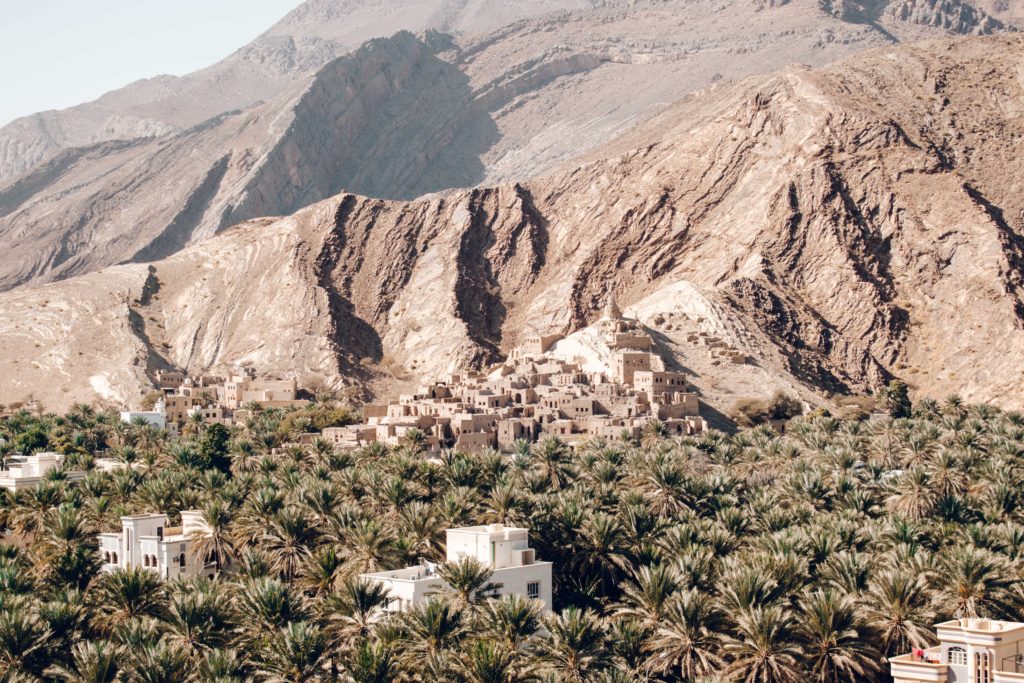
Oman’s Al Hajar Mountains begin in the Musandam Peninsula, and stretch across the entire north east of the country to Sur. The section to the southwest of Muscat, known as the Western Hajar, is home to the highest and most dramatic summits – Jebel Akhdar and Jebel Shams.
Given its high peaks and remoteness, the Western Hajar has rightly developed a reputation as an adventure lover’s paradise. If hiking, climbing, camping, off-roading and expansive views are your thing, it should absolutely feature on your Oman itinerary. Jebel Akhdar offers adventure with good infrastructure, whilst Jebel Shams is a more remote, rustic option.
The Western Hajar is also a great destination for history lovers, featuring two of Oman’s most spectacular forts – Bahla and Jabreen – and the former capital of Oman, Nizwa. And if laid back luxury hotels and beautiful spas are more your cup of tea… the Western Hajar has those too!
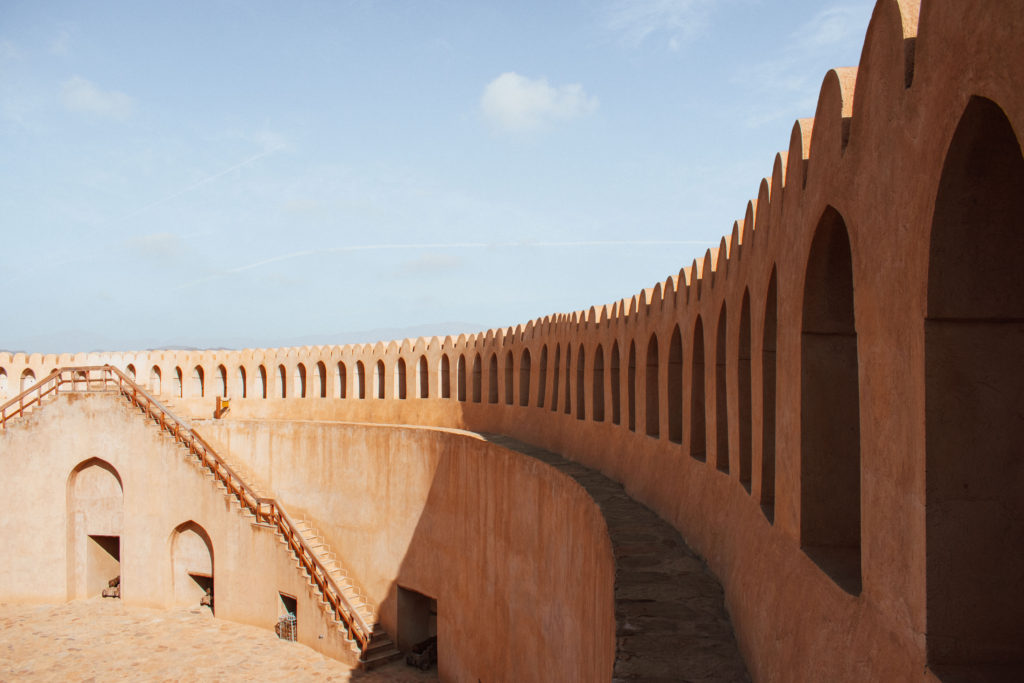
NIZWA
The capital of Oman in the 6th and 7thC, and the stronghold of the powerful Imams until the 1950s. Nizwa continues to be a centre of Islamic learning and is known to some as the “Pearl of Islam”. Around 165km, and about a two-hour drive from Muscat, Nizwa unsurprisingly features on almost all Omani tour itineraries.
WHAT TO DO
Nizwa Fort – the oldest in Oman, and the Sultanate’s most visited national monument. Built in the 9thC by Imam Sultan Bin Saif Al Ya’rubi and renovated in the 17thC. It was a stronghold against raiding forces and held a strategic location at the crossroads of vital trading routes. The views from the top of the 40m tower over the surrounding date plantations and Hajar Mountains are fantastic.
Go as soon as it opens, or just before sunset, for beautiful golden light on the Fort walls. Each weekend, the Fort hosts performances with live Omani music, dancing and singing in the courtyard. (Sat to Thu, 8am to 4pm, and Fri, 8am to 11am only)

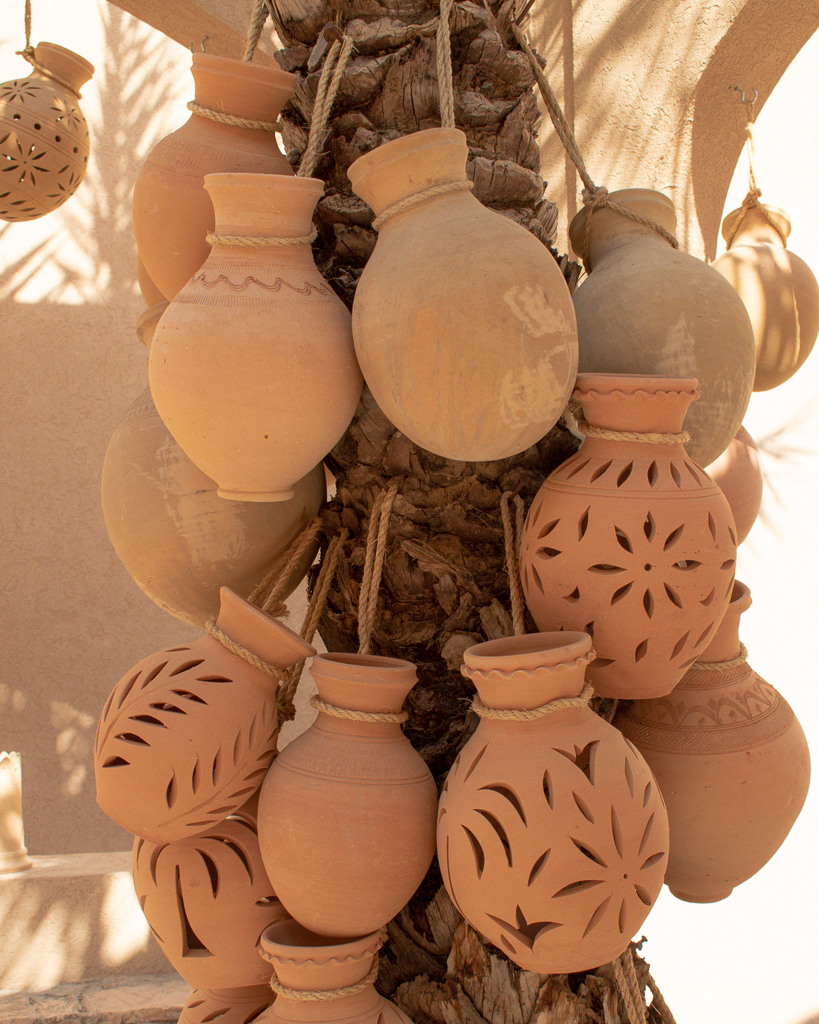
Al Qala’a Mosque – whilst not open to non-Muslims, this is still a tourist favourite as it is so photogenic! There is a great, eye-level, view of the qubba (the dome on top of a mosque, providing a symbolic representation of the vault of heaven) and minaret from the Fort.
Nizwa Souq – one of the oldest in Oman, and to my mind, one of the best! Vast, more recently renovated halls offer extensive fruit, vegetable, meat and fish selections, whilst the section nearest the Fort sells handicrafts and souvenirs. Nizwa is particularly well known for its intricate silver khanjars – the traditional curved dangers worn by Omani men – and also sells an extensive array of traditional pottery from nearby Bahla.
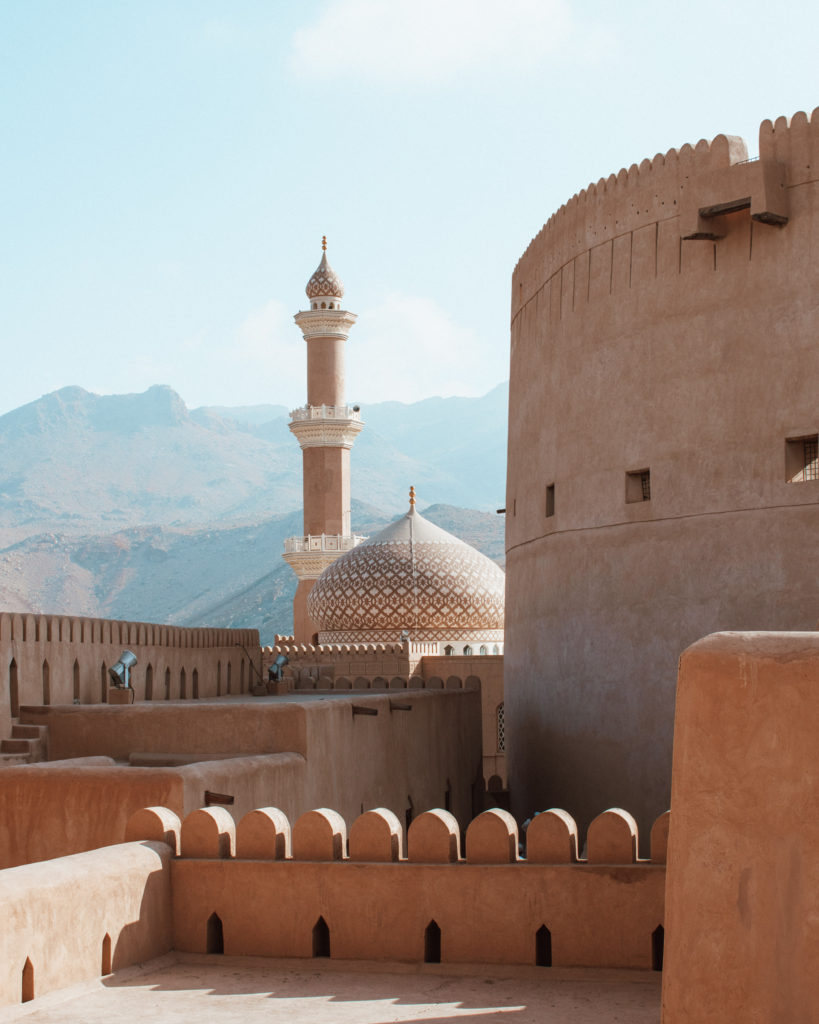
The Interior versus the Coast
Between the 17th and 19thC, following the expulsion of the Portuguese, Oman was a single unified country.
However, as Oman’s economic fortunes waned, serious divisions emerged between the religious Imams of the interior, and the Al Said family who presided over Muscat and the coast. By 1913, Oman had effectively split into two countries. It wasn’t until 1932 that Sultan Said Bin Taimur regained control of Nizwa and Jebel Akhdar, and reunified Oman.
The discovery of oil in the 1950s, lead to another period of unrest. The interior tribes under their elected Imam, Ghalib Alhinai, sought to prevent the Sultan and the British government from taking control of the oil wells. The “Jebel Akhdar War” broke out in 1954 and again in 1957, and saw extensive fighting in and around Nizwa. The Sultan and his allies eventually captured the interior in 1959 after four years of fighting, once again uniting the coast and interior of Oman.
Goat Market – every Friday between 6am and 9am a large livestock market is held behind the main souq. It is a fascinating glimpse into centuries-old traditions and modern agricultural Omani life. Just be sure to follow the local lead and step back a bit once they start to bring the bulls around! The exact start time depends on the time of year, and the heat, so ask your hotel to confirm what time it will kick off during your visit.
Bahla Fort – one of the largest forts in Oman, just over half an hour outside of Nizwa. It is Oman’s only UNESCO-listed fort – recognising its values as an example of a fortified oasis settlement of the medieval Islamic period. The fort and settlement owed its prosperty to the Banu Nebhan tribe, who dominated the central Omani region and made Bahla their capital from the 12th to the end of the 15thC. Unfortunately, there are limited exhibition boards, and little information on the fort, but it still makes for a fascinating afternoon exploring.
Jabreen Castle – half an hour from Nizwa, this castle is absolutely not to be missed! Built in 1675 by Imam Bil-Arab Bin Sultan, it was a centre of astrology, medicine and Islamic law. It is one of the best preserved castles in Oman, and unlike many, is still quite highly decorated – in particular the elaborately painted ceiling of the Sun and Moon Room where the Imam would receive visitors. The vast castle covers five floors and 55 rooms, with a falaj running through the middle courtyard.
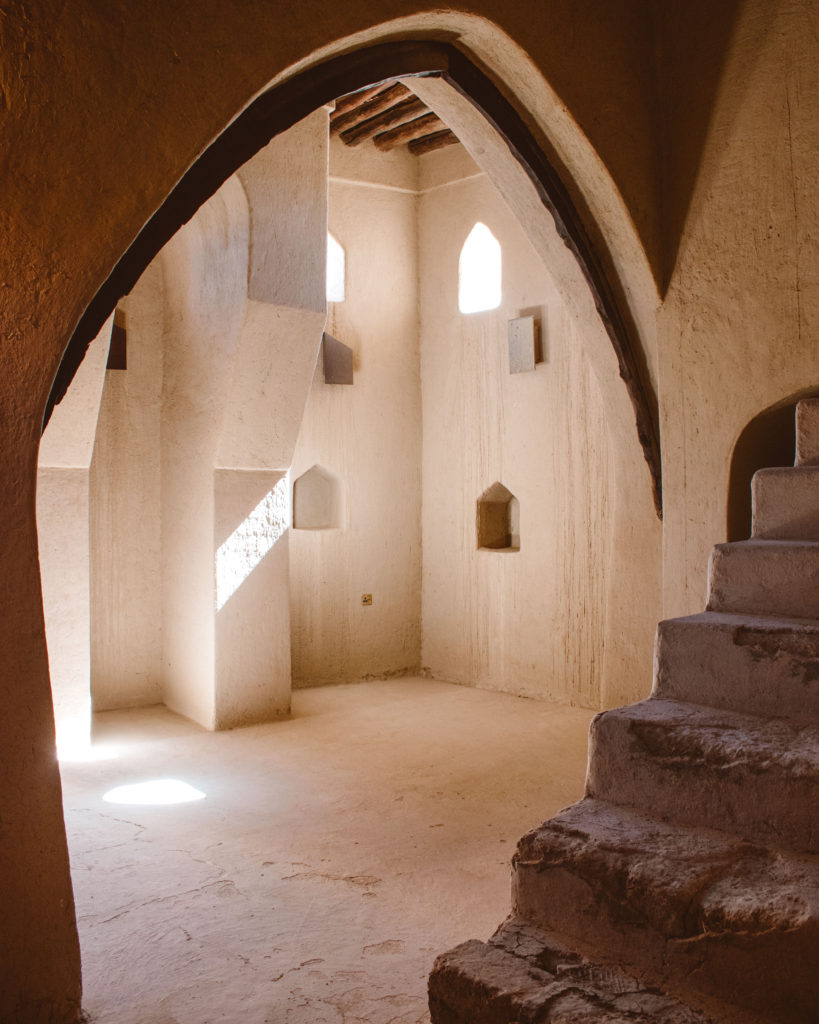
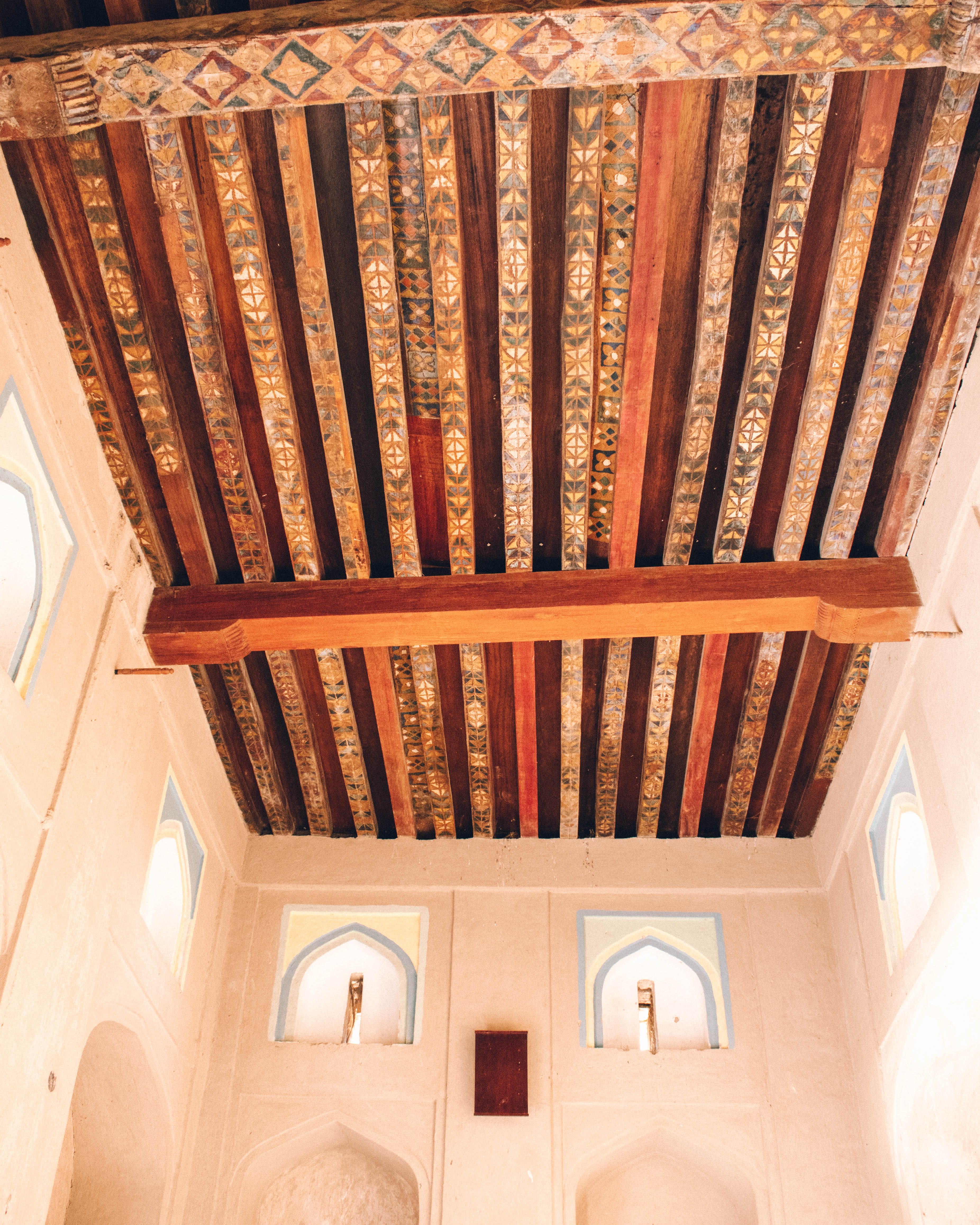
WHERE TO EAT
Whilst visiting Nizwa Fort, be sure to buy a traditional Omani pancake drizzled in butter and honey from the ladies in the courtyard. They are like crisp, crackly flatbreads.
Al Zuhly Restaurant – big portions of tasty kebabs, shawarma and biryani at this simple street side eatery. Drivers honk their horns to order takeaway so expect a degree of chaos! The views are unbeatable, especially at night, over to the souq and Fort.
Anat Cafe – a relatively new addition in the old city walls. Coffee, cold fruit drinks and a few pastries. Order at the counter and find somewhere to sit at the tables along the top of the walls.
WHERE TO SLEEP
Nizwa Antique Inn (££) – easy walking distance to both the souq and the Fort, set in lovely gardens in the old quarter with views from the roof terrace over the fort. Rooms are basic, but spacious and comfortable, designed to replicate a traditional Omani house. There is also a small, courtyard pool. Be aware that although surprisingly comfortable, beds are low matresses on the floor – this might not be the best pick if you have mobility issues. Dinner can be booked on arrival – it is simple, but delicious. Check out my full review.
Nizwa Heritage Inn (£) – converted townhouse behind the souq. Rooms offer a glimpse into traditional life in the old quarter. Basic but comfortable, with lovely traditional design features and fabrics. The simple Omani breakfast was delicious.
Golden Tulip (££) – if you want something more luxurious and international, this is for you. Rooms are modern, clean and spacious. There is a large pool and an onsite international restaurant. It is a way out of town, so if you want to go to eat out in the evening you will need to drive.
JEBEL AKHDAR
Access to Jebel Akhdar (“Green Mountain”) requires a 4WD. There is a police check point at the bottom to confirm you have the right vehicle. This can make the drive seem scarier than it is in reality. The switchbacks that carry you up Jebel Akhdar are certainly steep, but perfectly manageable. The greatest risk comes from your breaks seizing on the way back down. Stay in a low gear to keep the car’s speed down, and try to use the brakes as little as possible. Hotels can arrange transfers if you do not wish to drive.
WHERE TO GO
Birkat Al Mouz – one of the first places we visited outside of Muscat, and still one of my favourites! This small abandoned village sits at the foothills of Jebel Akhdar, and on the edge of a thriving modern settlement. Try to visit in the early evening, as the golden light makes the mud-built houses and the surrounding date and banana plantations glow. The falaj – the ingenious Omani irrigation channels – is still in active use by the modern village, so ensure you are dressed respectfully as you explore.
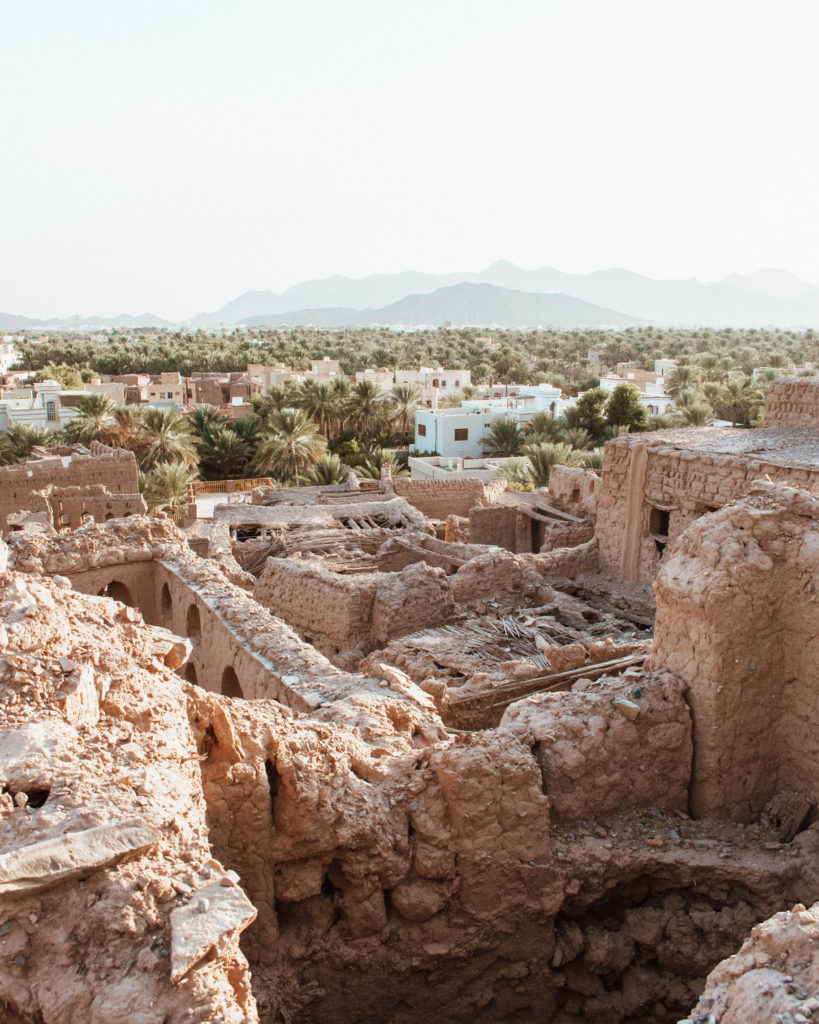

Hiking – Jebel Akhdar is one of Oman’s top hiking destinations. In the summer temperatures here can be as much as 15 degrees cooler than in Muscat, meaning it is one of the few northern destinations still viable for outdoor adventures in the summer months. Below are my favourite routes. None are too difficult to navigate, just follow the red, white and yellow markers painted onto the rocks.
- The Village Walk (W18b) – a really lovely 4km route winding through farmland and villages. This walk gives the stereotypical type of Jebel Akhdar views you see in guidebooks and on tourism sites! Start just below the Sahab and Sama hotels. It takes around 3 hours to do the whole route to Saiq.
- Mirage in the Mountains – starting right outside the entrance to the Alila hotel, this 9.5km route leads to an abandoned village. It has more ascent than some (200m), so offers a bit more challenge. The entire route takes about 3 and a half hours.
- The Discovery Trail – 5.3km downhill trail from Hayl Al Hadab to the Alila hotel. Although the trail is not steep, there are some fairly sheer drop-offs alongside the route.
- W25, W24a and W24b – three national trekking routes running through the village of Wakan. These are the most challenging of this selection by a fair margin – and all pretty steep whichever direction you do it in. Definitely one to take your hiking poles for! Check out my full guide to Wakan to plan your trip.
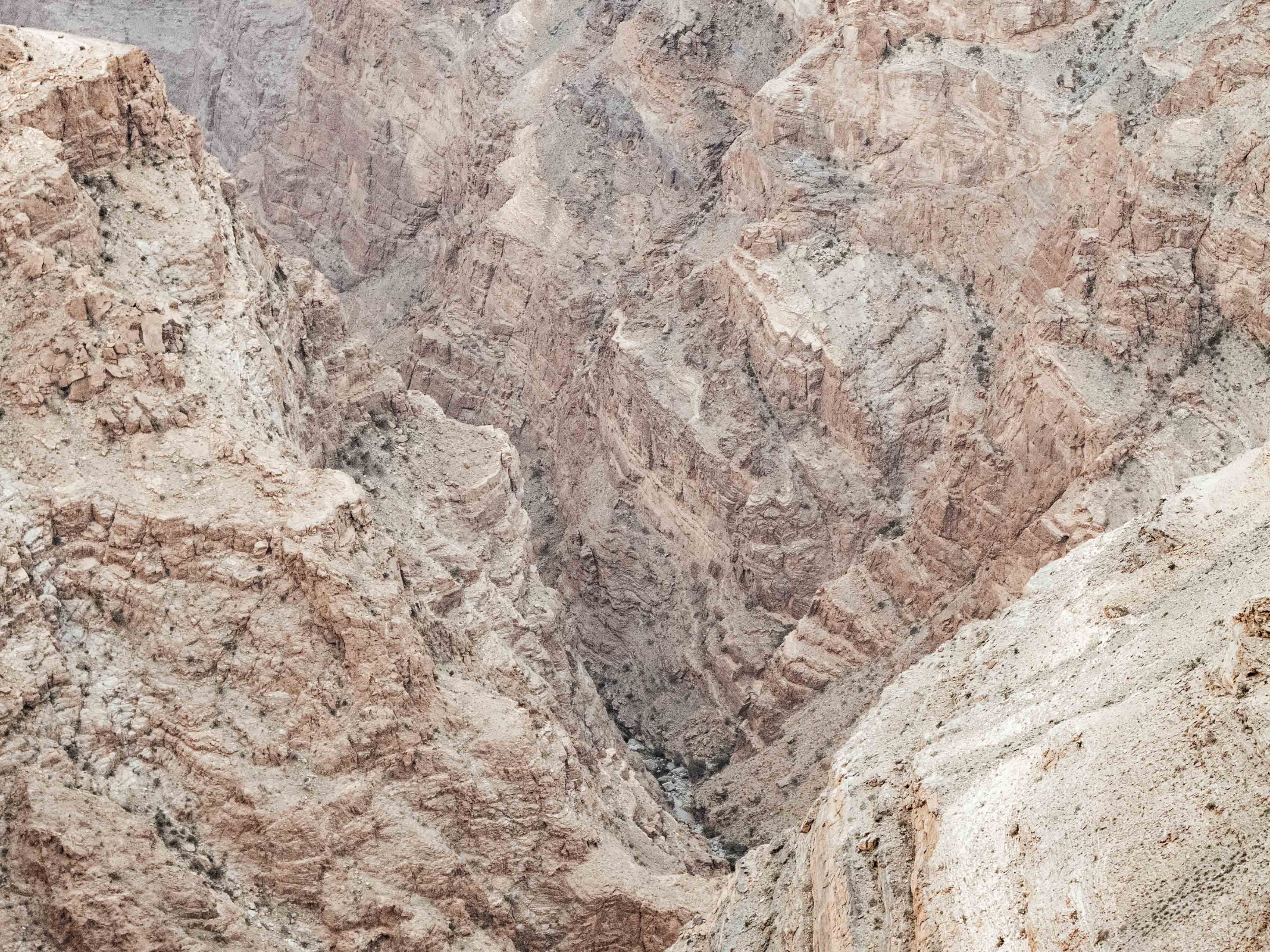
Via Ferrata – if you are looking for a burst of adrenaline, Jebel Akhdar’s two luxury hotels both have via ferrata routes. The Alila’s is half a mile long and includes a high-rope 82ft above a cave mouth; whilst the Anantara offers a 200m route, including Oman’s first mountain zipline. The Anantara is the gentler of the two, and is less physically strenuous. If you haven’t climbed before, or are nervous about heights, go for the Anantara. But if you have previous climbing experience, the Alila route is likely to offer you more – although perfectly doable if you are an adventurous novice! Guides at both were fantastic. Both can be booked without staying at the hotels, subject to availability.
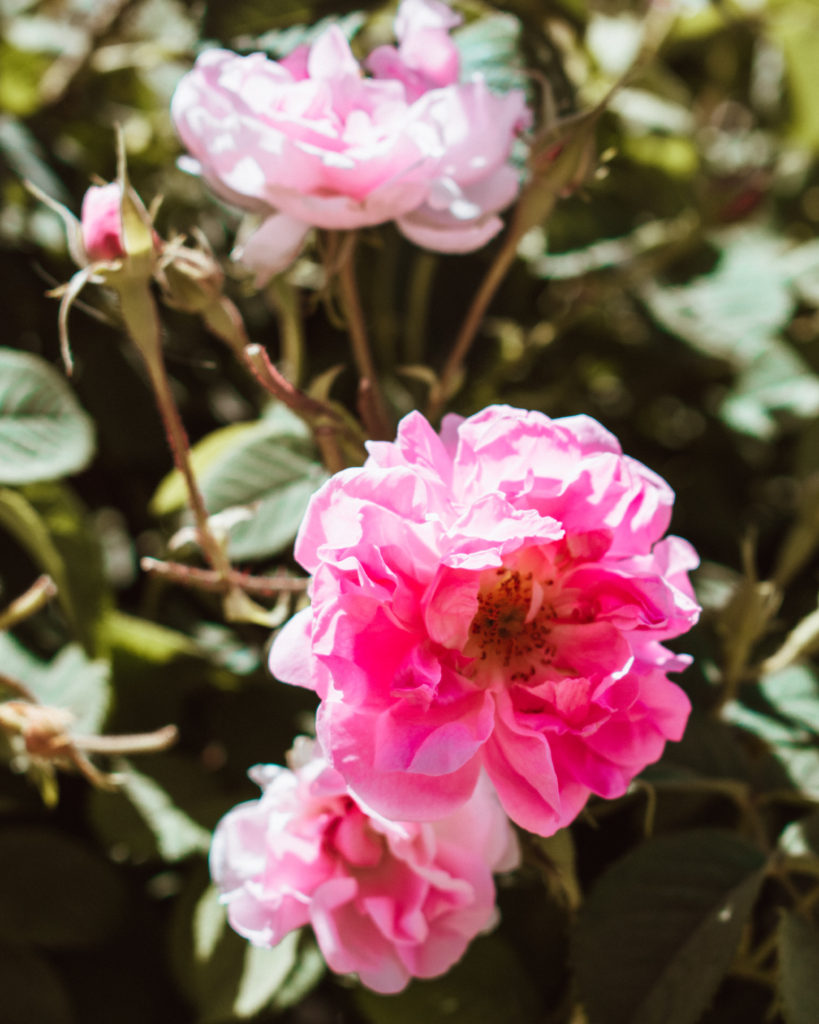

The Rose Harvest – every year, from mid-March to mid-April, Jebel Akhdar erupts into pink as 7,000 blooming damask roses cover the mountain. For the entire month they are in bloom, local farmers will harvest virtually twenty-four hours a day before turned the roses into one of Oman’s most well-known exports – rose water.
You can visit independently – just follow the route of the W18b trail. But I highly recommend getting a guide to learn about this fascinating, and traditional, industry. We went with A J Tour Oman and our guide was hugely knowledgeable about the process, and also Oman as a whole. The main hotels on Jebel Akhdar will also organise excursions.
Wakan’s Blossom Season – between mid-February and mid-April the small mountain village of Wakan is awash with flowering apricot and pomegranate trees. Wakan is also a popular hiking destination, and a possible day trip from Muscat. Check out my full guide to Wakan to plan your visit.
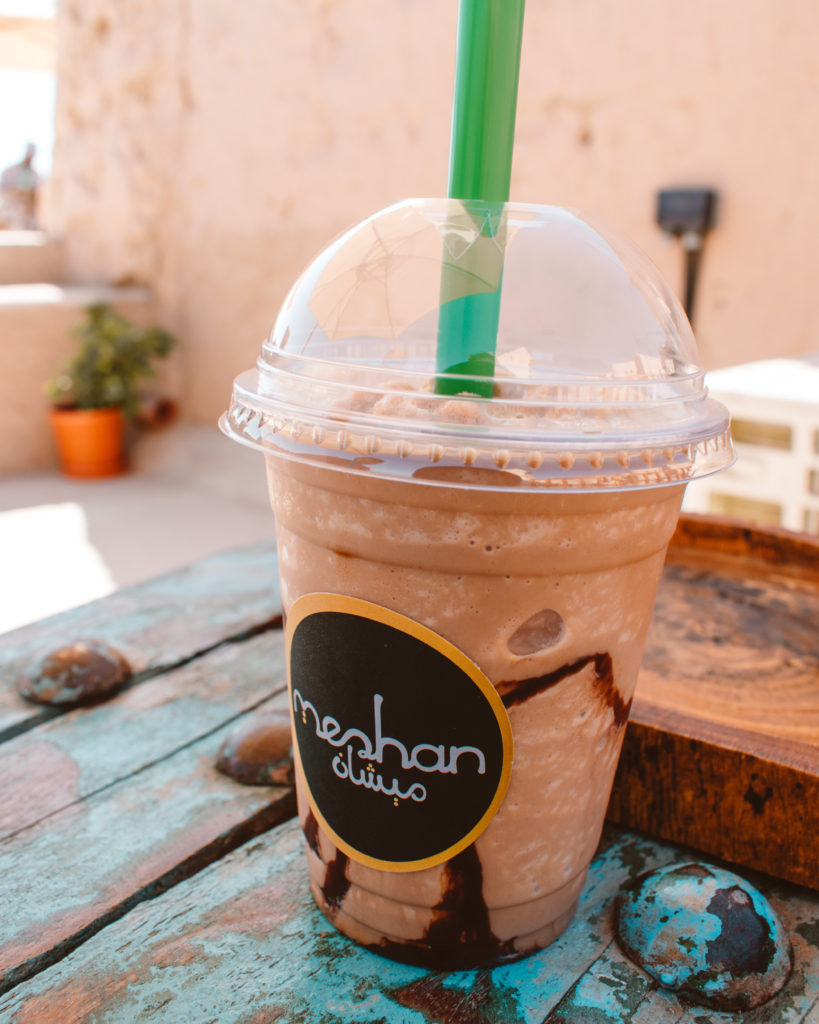
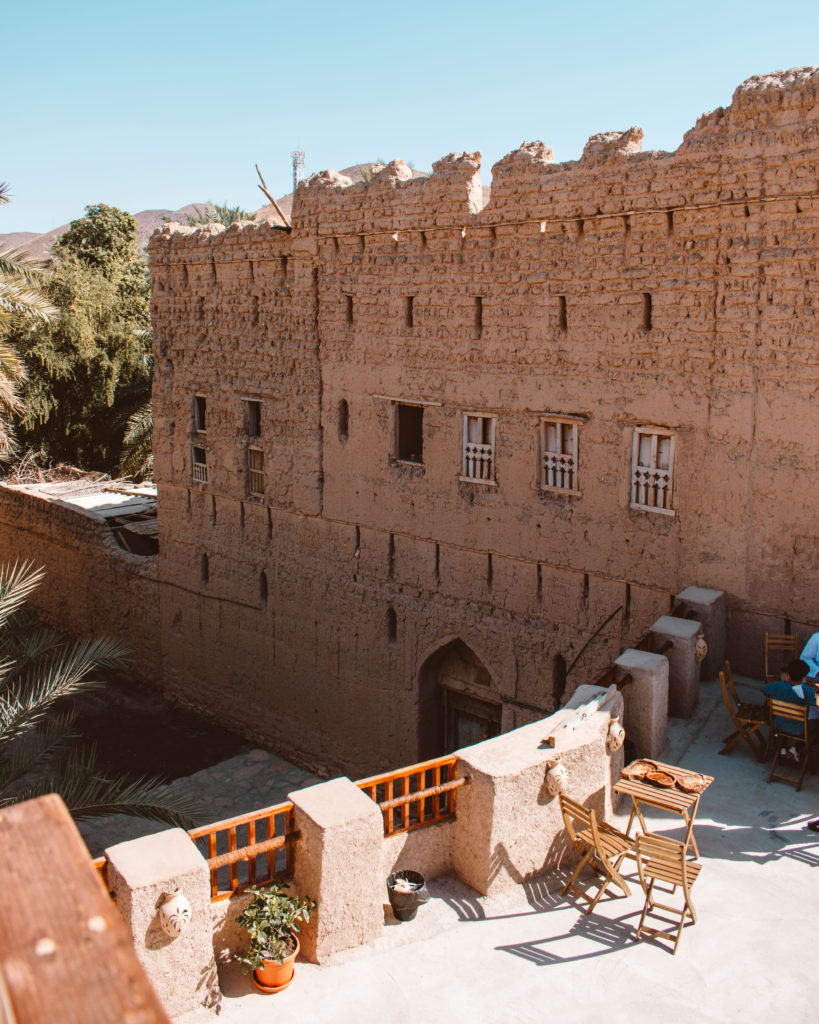
WHERE TO EAT
Bait al Sabah – lovely café and guesthouse in the old village of Birkat al Mouz. I love how this sensitive restoration of the café and guesthouse is breathing new life into this historic spot and look forward to staying here soon.
Kawa Kava – slightly unexpectedly sleek café immediately before you start the drive up Jebel Akhdar! It’s somewhat hipster vibe lends itself to higher prices, but the coffee is excellent and the food good.
Robo’u Alsaab Restaurant – good value shawarma under colourful awnings on the main road through Saiq. Food is uncomplicated but tasty. Can be busy in peak season.
The Peak – lovely new coffee shop in the Sama Hotel in Saiq. This light, airy space serves premium cold brews and a small selection of cakes and pastries.
WHERE TO SLEEP
Camp (free!) – Jebel Akhdar is one of the most popular weekend camping destinations in Oman. I’d recommend heading towards the Alila hotel to find a quieter spot with less light pollution, rather than camping nearer to the sizeable plateau town of Saiq.
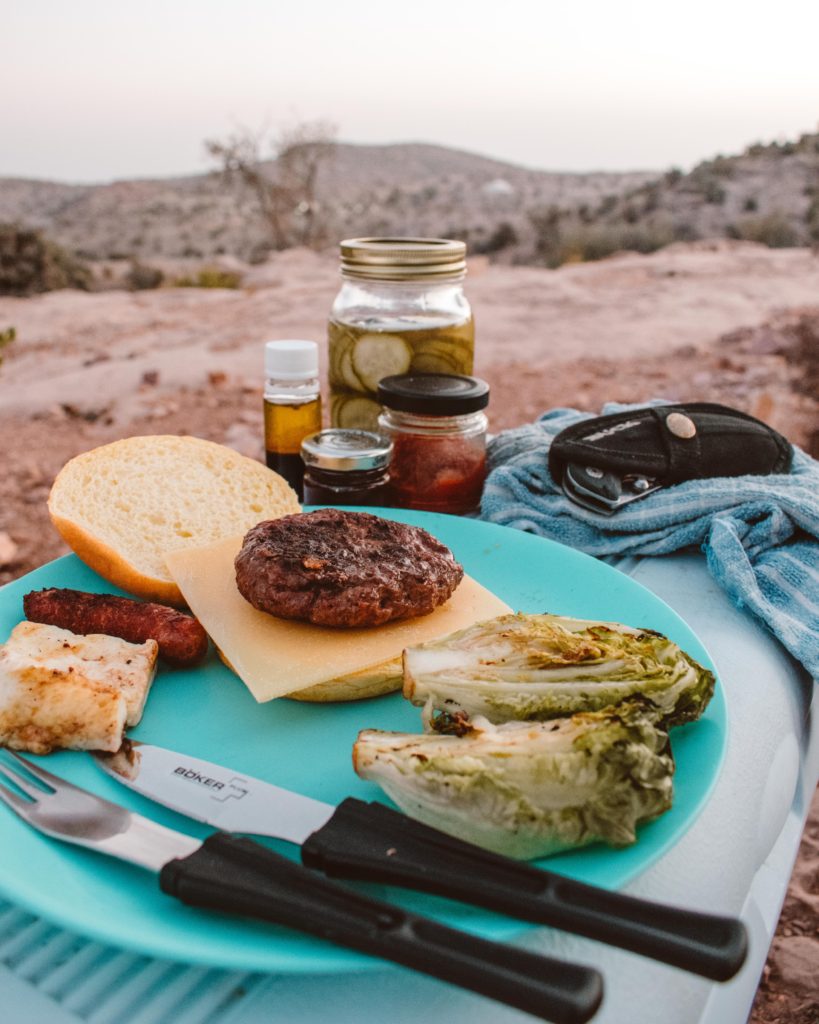
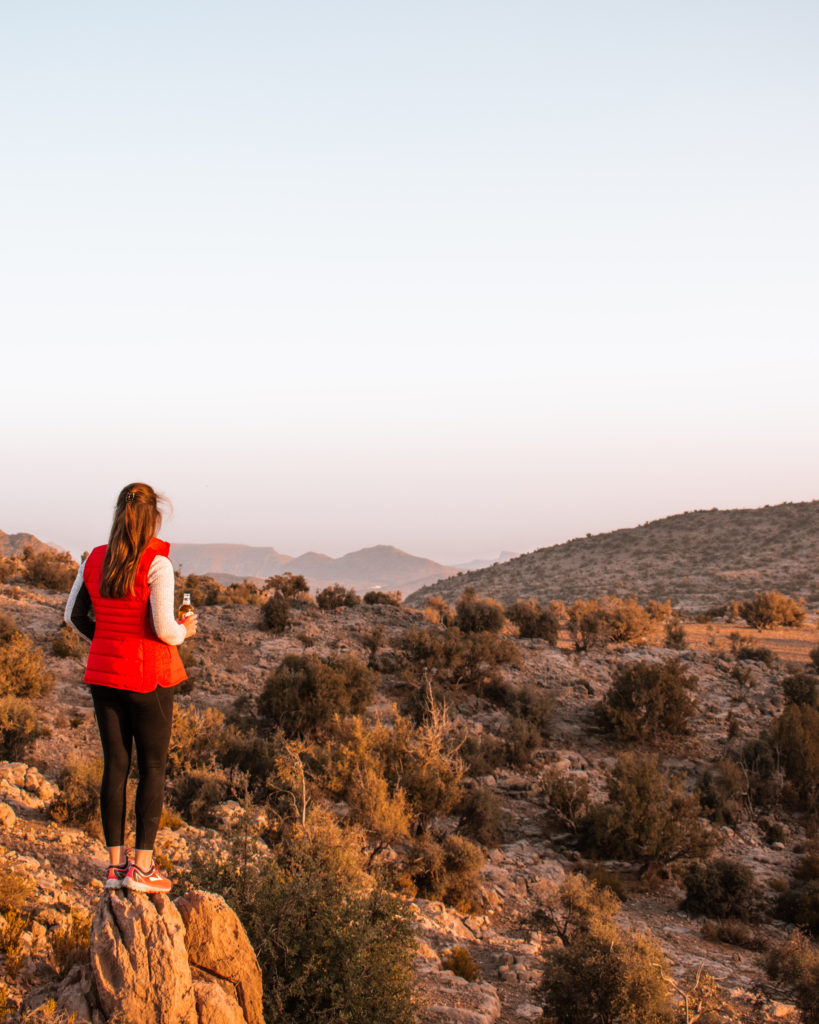
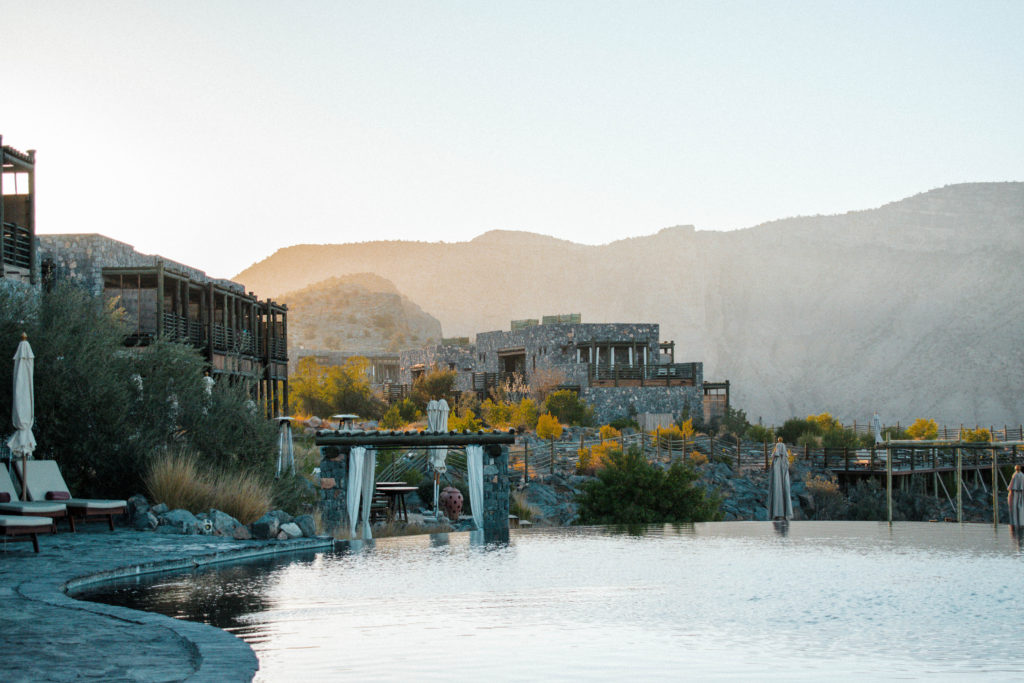
Alila Jebel Akhdar (£££) – my favourite hotel (to date!) in Oman! Luxury rooms and an infinity pool perched on the edge of a 2,000m gorge. Check out my full review for more details.
Anantara Jebel Akhdar (£££)– all rooms have fantastic views, with minimalist and elegant decor. Designed to emulate an Omani fort. The central courtyard is seriously beautiful, and has a lovely vibe for evening drinks. It is not hard to see how this hotel has frequently topped some of the “best hotel” lists worldwide.
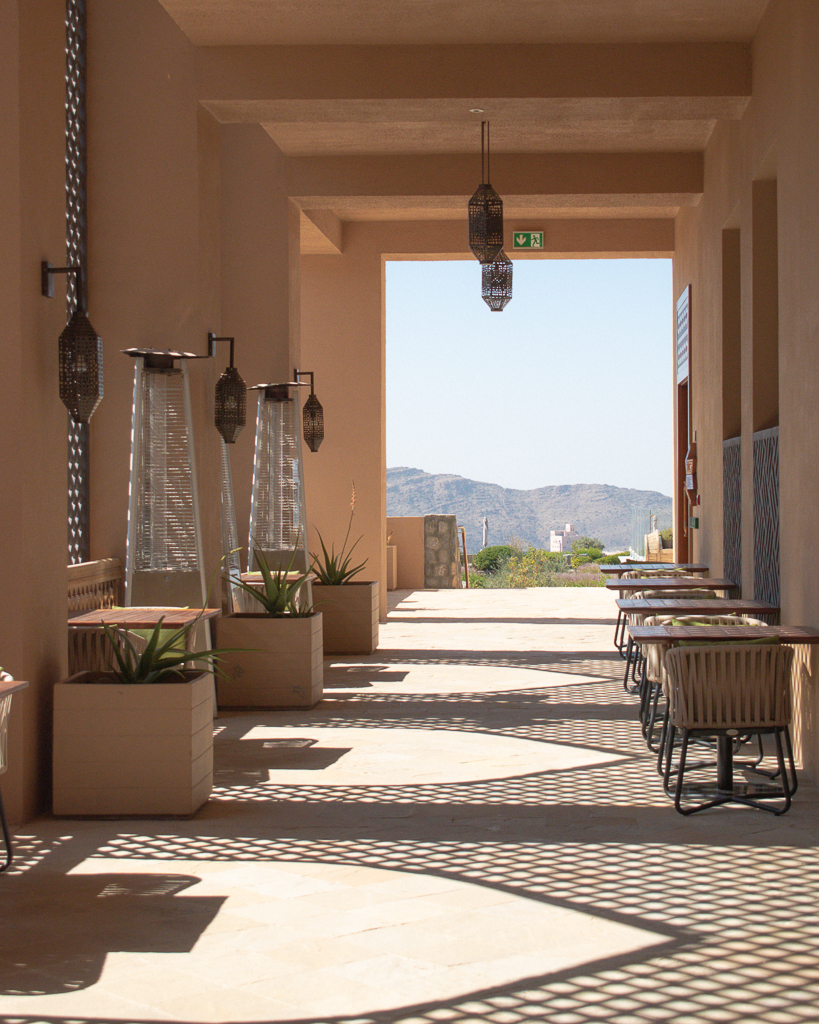
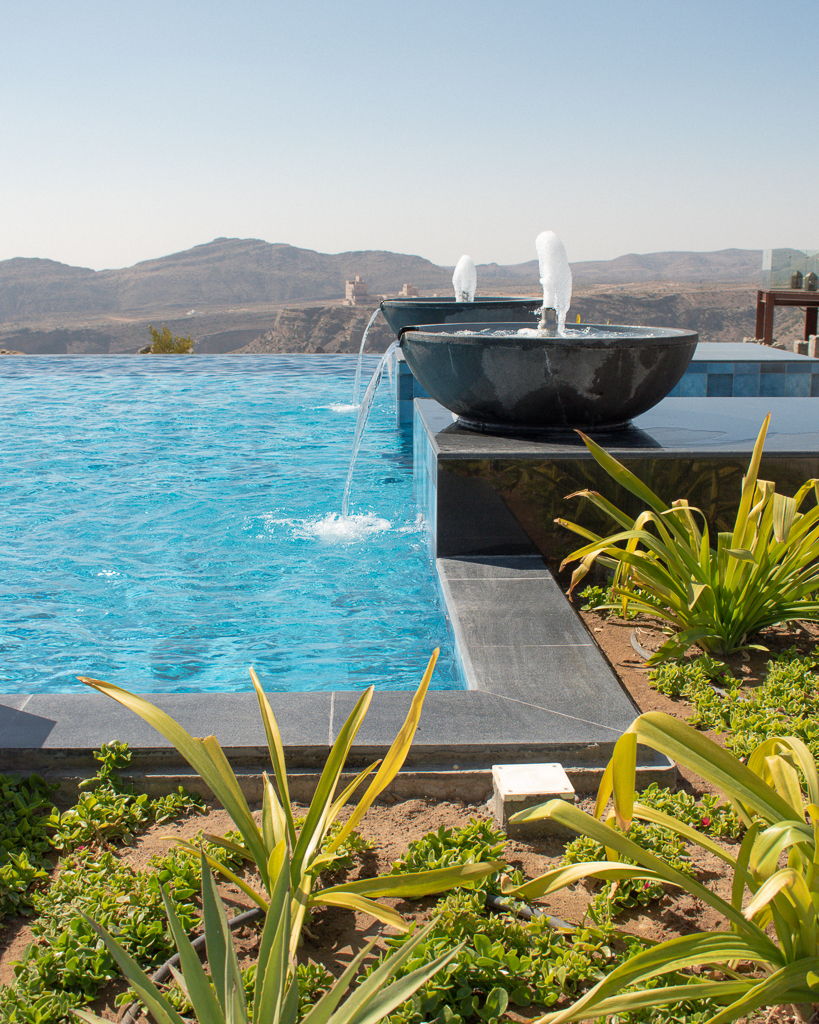
Sama Jebel Akhdar Hotel (££) – identical views to the Anantara next door, but at a fraction of the price. There is a small pool, but as with all on top of Jebel Akhdar can be cold in winter months. The recent addition of a lovely, light, airy coffee shop is super. A fantastic option if the prices of the Alila and Anantara put you off.
Sama Wakan Heritage Hotel (££) – rooms are basic but comfortable, with added heritage details. It is also the only place to eat in the village, and a simple (but very tasty!) dinner and breakfast are included in the price.
JEBEL SHAMS
Roughly 240km from Muscat, this is Oman’s highest mountain and home to the Grand Canyon of Oman – Wadi Ghul. If adventure is your thing, this is the destination for you. Unlike Jebel Akhdar, a 4WD is not officially required to visit Jebel Shams (“Sun Mountain”). But as the last section is on unpaved, soft – and in places steep – track I would strongly recommend it. Not least as it means you can get to the best camp spots…
WHERE TO GO
Al Ain Beehive Tombs – Oman’s beehive tombs are one of the most complete necropolises dating from the 3rd millennium BC anywhere in the world. They were designated a Word Heritage Site in 1988 and continue to be explored by archaeologists looking for clues to Oman’s ancient history. This is one of the easiest sites to see them, and also offer one of the best views. Drive down to the wadi, and it is only a short walk up to the tombs themselves.
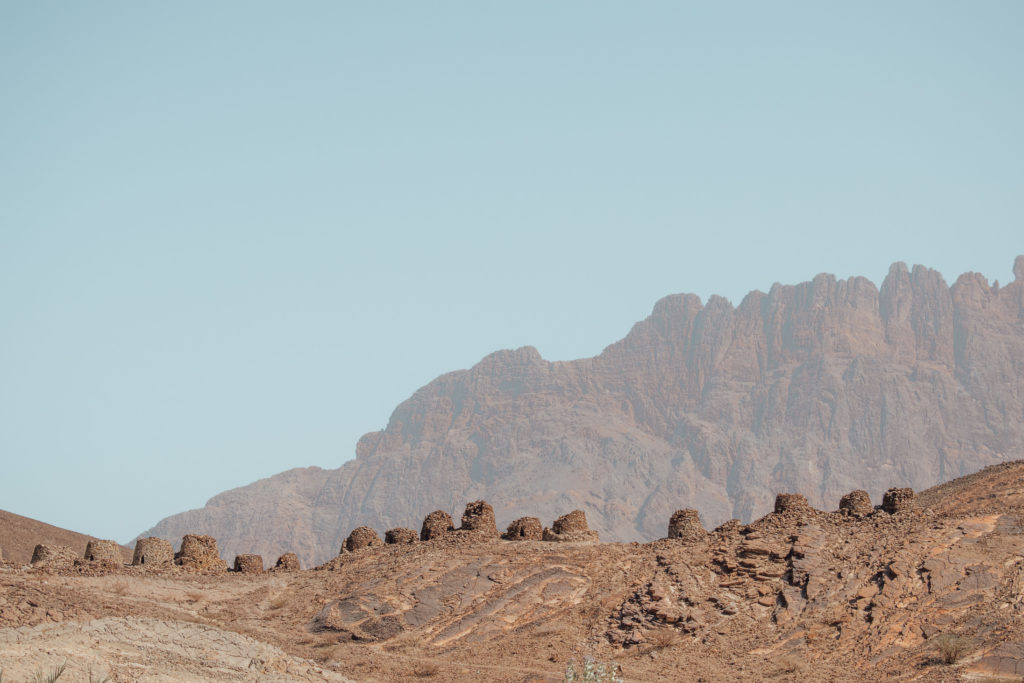
Wadi Damm (also Wadi Dhum) – a seasonal wadi, and the pools sometimes are dry. After about a 10 minute walk, there are several large boulders blocking the path. There is a rope in place to pull yourself through a crack in the rocks to continue onto the rest of the pools. It is not difficult but slightly claustrophobic. A 4WD is needed – follow your sat nav to the parking, turning off the road just before the bend.
Wadi Ghul – also known as Oman’s Grand Canyon, Wadi Ghul is a 500m deep canyon on Jebel Shams. If hiking and climbing aren’t for you, you can get an incredible view down the canyon from the view point just off the road.
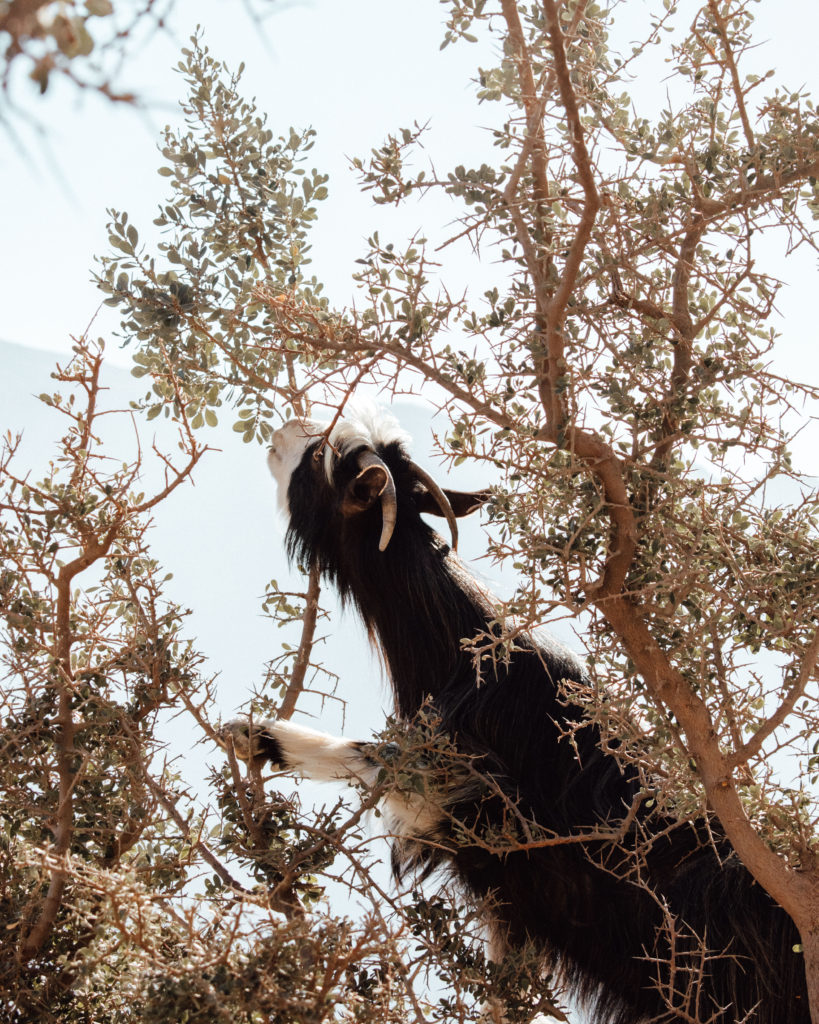
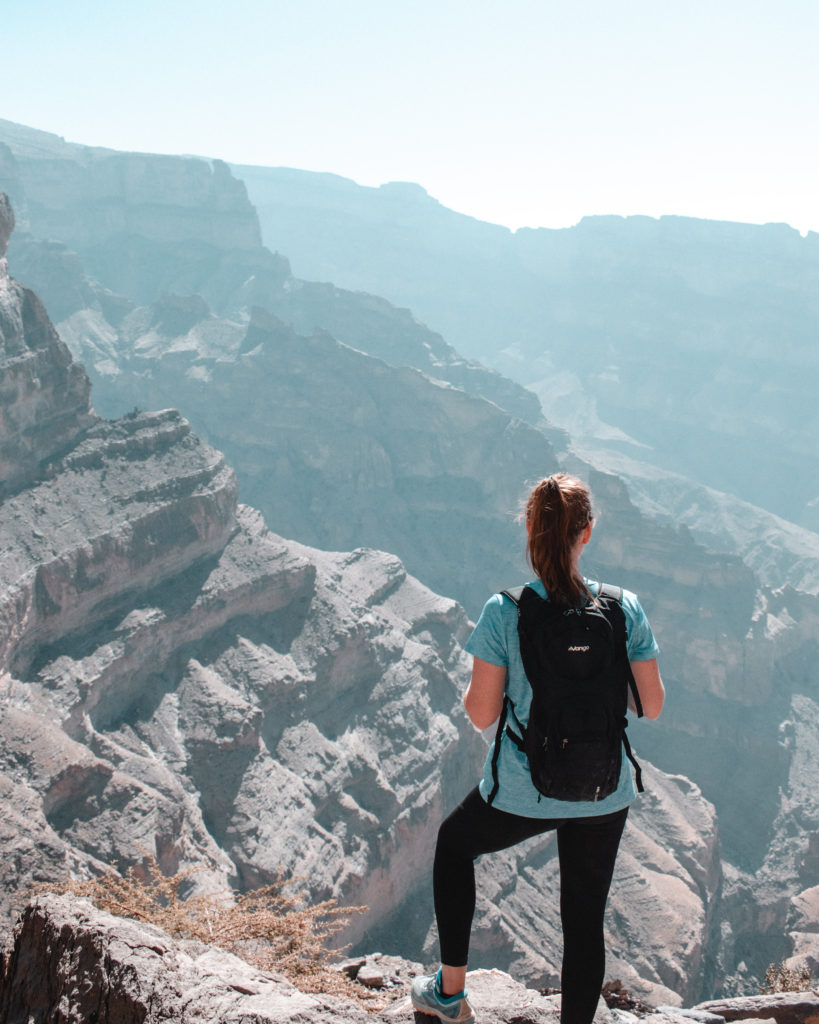
The Balcony Hike (W6) – one of Oman’s most well known, and best hikes, along the rim of Wadi Ghul. It is a 4km walk (staring here) with around 200m elevation change. The route out is downhill – you start at 1,900m and go down to around 1,700m. It takes around three hours, and it’s a there-and-back route. Go early to avoid the crowds, and the sun at its strongest. Many people turn back at the abandoned village, but if you keep going the path climbs up above the village for about 100m to a small pool and cave. It makes a lovely, shaded lunch spot. There is also a via ferrata course above the cave – companies such as Twenty 3 Extreme can arrange excursions. The balcony walk can be extended by adding the steep W6a, which works its way up the mountainside from the village of Al Khatim.
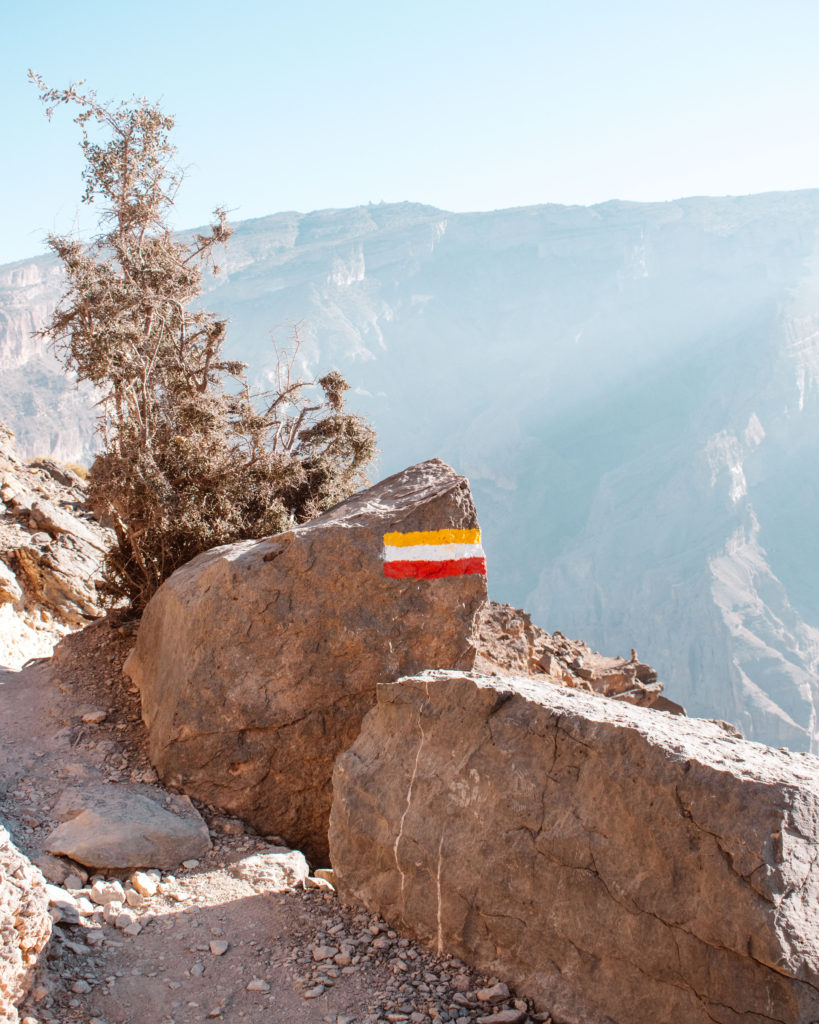
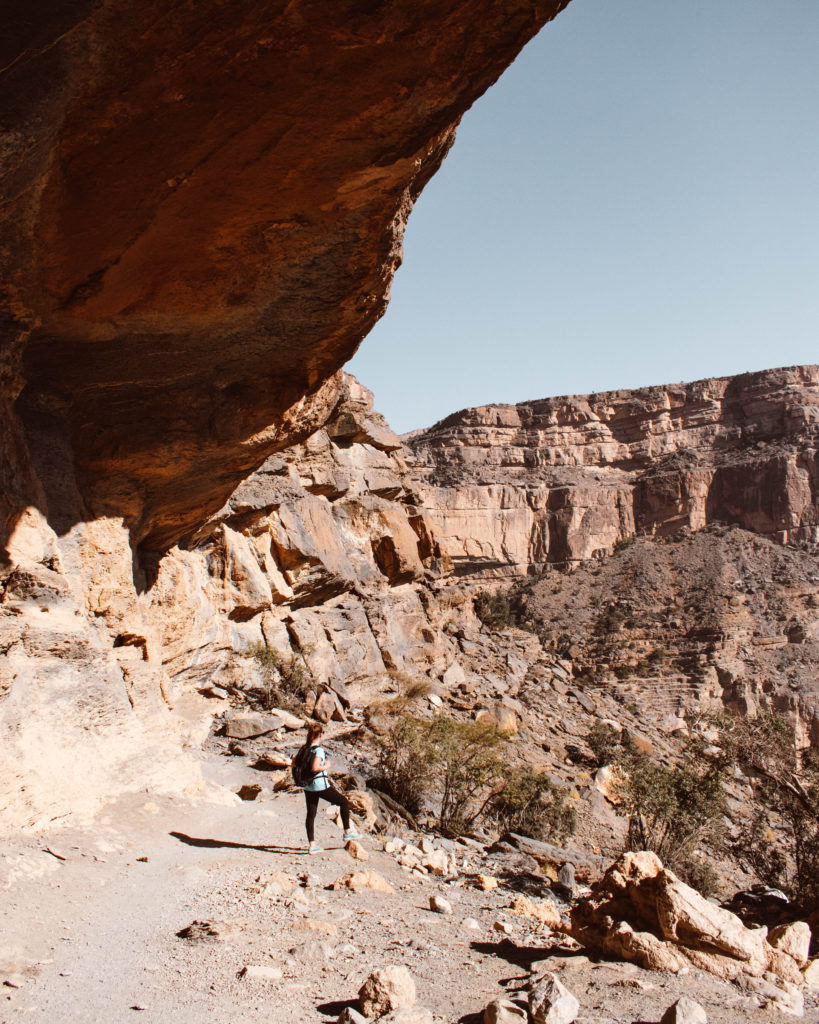
Jabal Shams Summit Hike – the strenuous, exposed 9km W4 takes you up to the southern summit of Jebel Shams. This is one for experienced hikers, and the round trip is around 10-12 hours hiking covering 1,000m of elevation gain. I recommend camping the night before (or staying at the Sama Heights Resort), and doing it as a round trip in one day. This avoids having to carry your camping kit with you. You will need to carry a considerable amount of water, as there is no water source on route. Be aware that the “true” summit of Jebel Shams is off limits due to the presence of a military base.
WHERE TO EAT
There are very few places to eat on Jebel Shams – this is the place to have a rustic BBQ or cook up a storm on your camping stove!
Outside of the hotels, the best bet is the coffee shop near the sign for Dar Lawi, by the picnic shelters. Fresh paratha and a dhal are a bargainous 2 OMR.
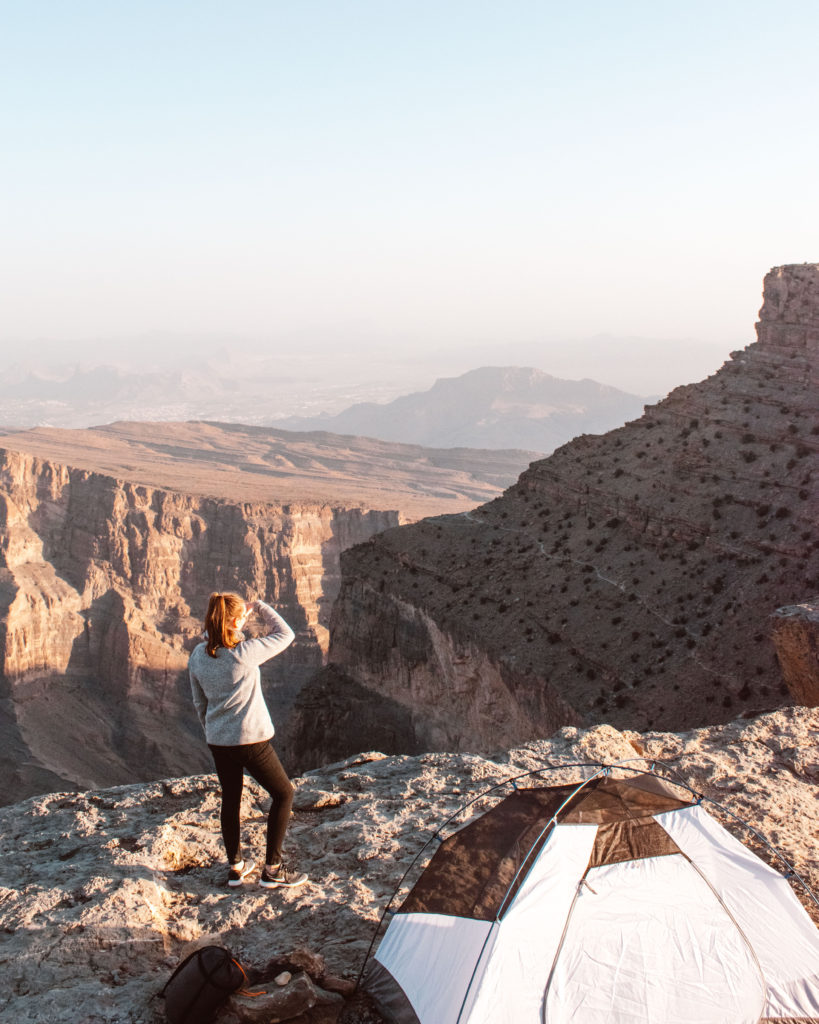
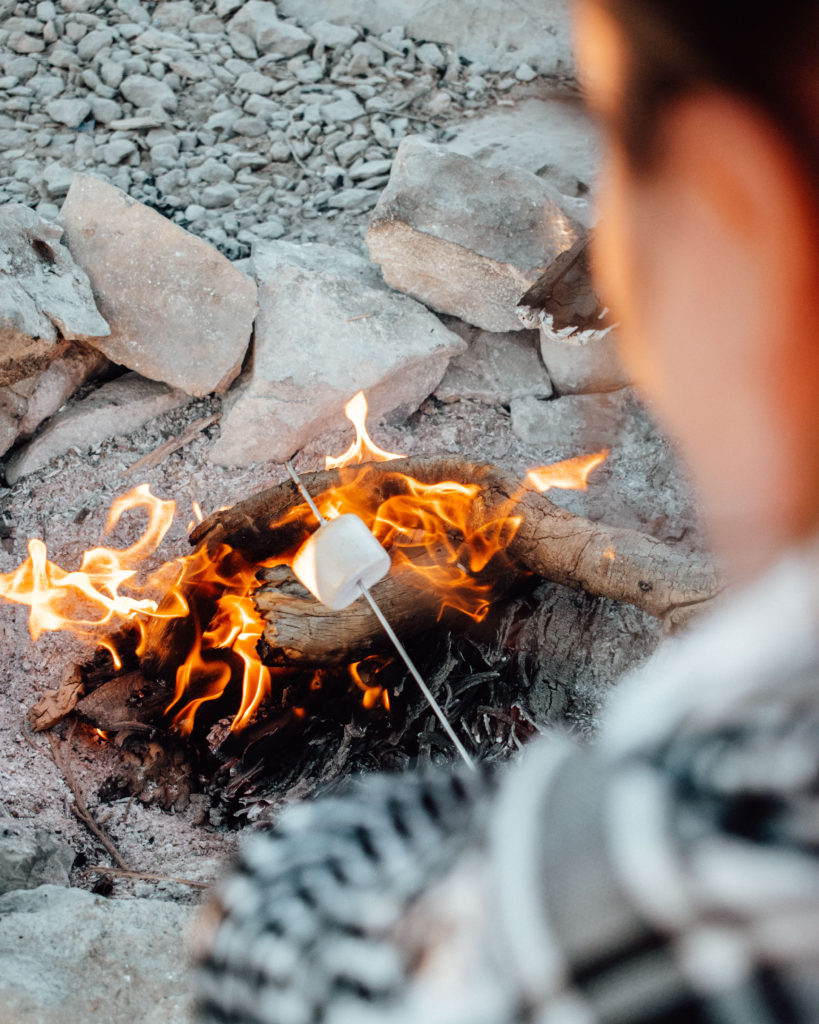
WHERE TO SLEEP
There are only a couple of hotels on Jebel Shams, but we have found them to be very disappointing. Given how amazing the camping is, I really recommend sticking to your tent, although I have shared the hotels below in case camping is really not for you.
Camp (free!) – camping on the edge of Wadi Ghul and seeing the night sky fill with stars is a memorable way to spend a night. The most popular spots are just after the main view point, and can get busy at the weekend.
Sama Heights (££) – stone cabins and Bedouin tents. Rates include dinner.
Jebel Shams Resort (££) – cosy stone cabins, and a selection of Arab-style tents. The pool is unheated.
AL HAMRA AND MISFAT AL ABRIYEEN
Tanuf Ruins – a visible reminder of the Jebel Akhdar War; the town was bombed in the 1950s by the British Royal Air Force at the request of the Sultan. It makes an interesting short detour, to explore the old village.
Al Hamra – one of the oldest settlements in Oman. The old abandoned quarter has a collection of well-preserved two- and three-storey mud-brick houses built in the Yemeni style. Come at sunset to see the honey-coloured buildings glow. The wonderful Bait al Safah museum (3 OMR) is run by a group of local women who showcase traditional arts and crafts in one of the old houses.
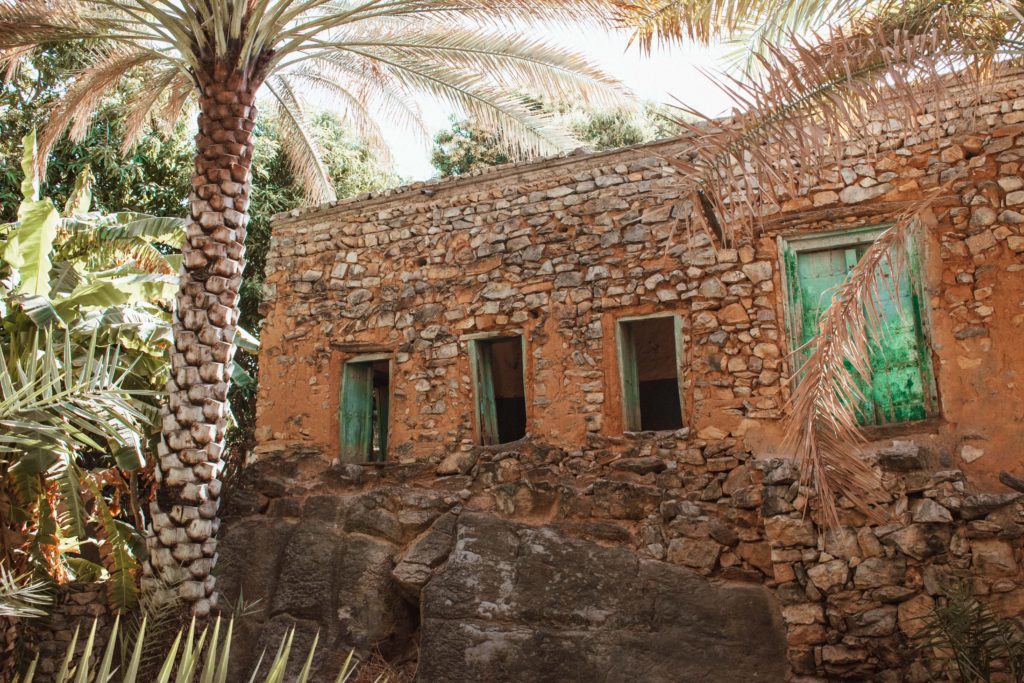
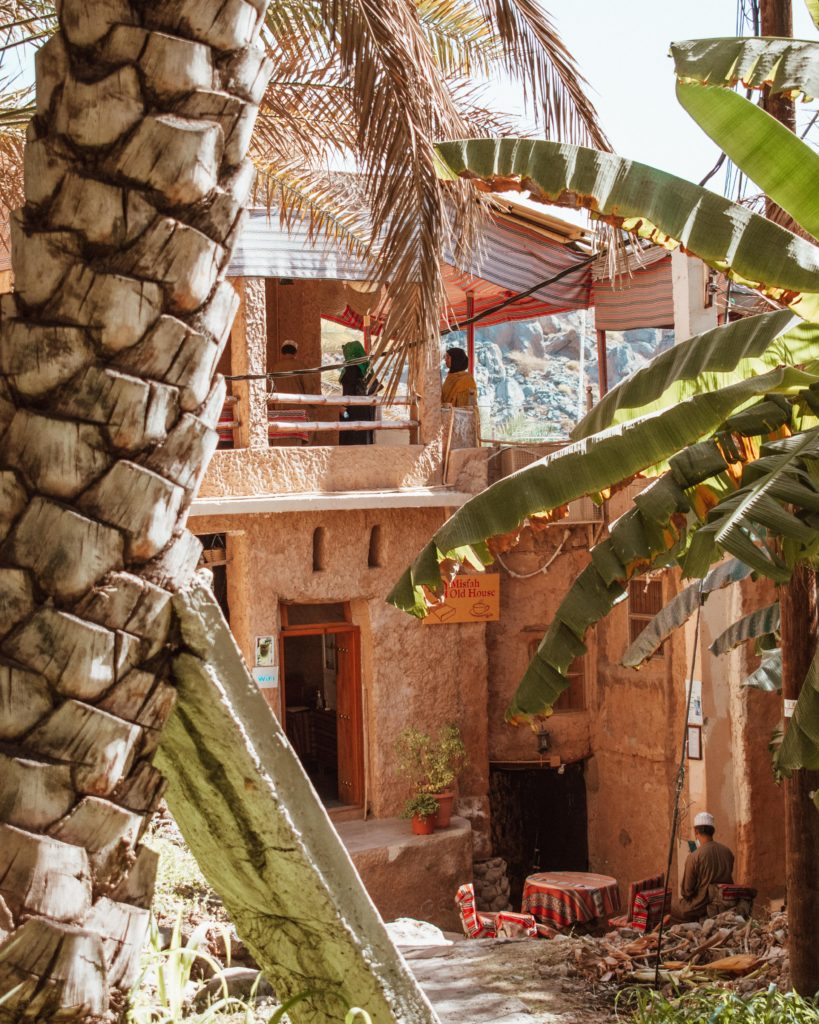
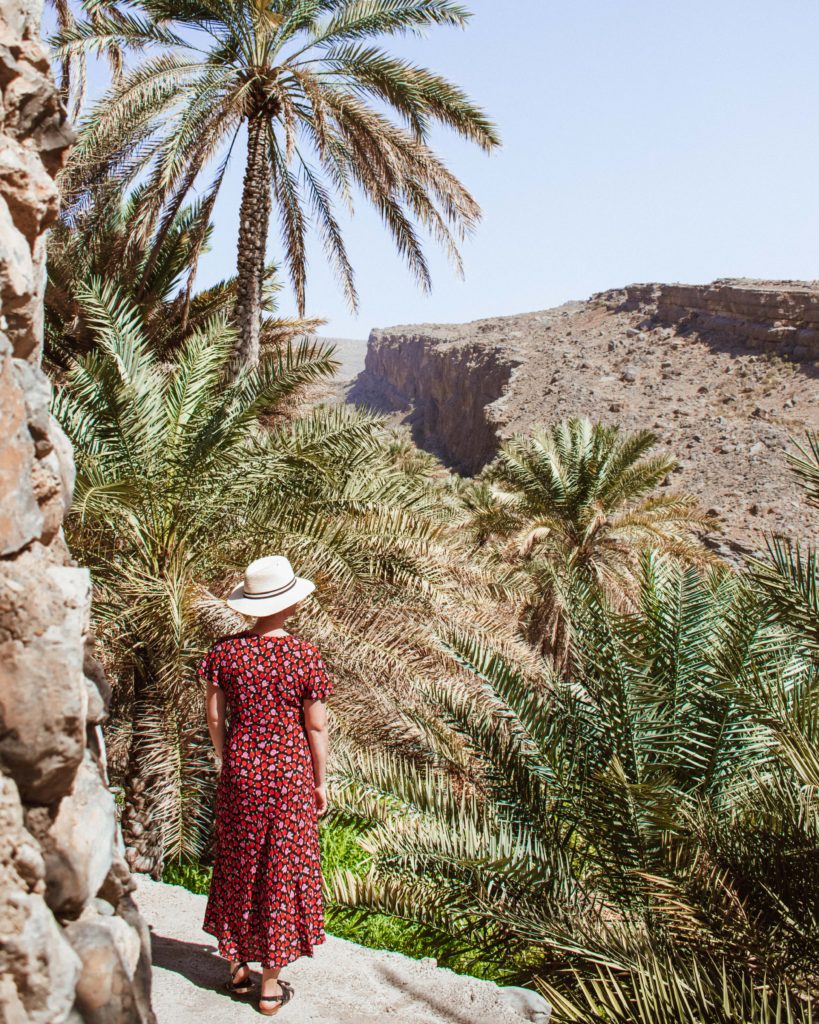
Misfat Al Abriyeen – picturesque village located on the foothills of the mountains about Al Hamra. There are two lovely, very gentle, walks at either end of the village, which take you through the date plantation, along the falaj system. Routes are marked by the familiar yellow, green and red flag that marks most hiking tracks in Oman. Be sure to stick to the paths to avoid straying into private properties, or damaging crops. As it is one of the few mountain villages accessible by 2WD, Misfat has become a very popular tourist destination in recent years, so try to avoid the weekends if you can.
WHERE TO EAT
Rogan Café – gorgeous interiors and a lovely view over Misfat Al Abriyeen. The coffee is fairly average, so unless you are desperate for a caffeine hit, stick to the fresh juices! Good cakes.
Alstromeria Café – lacking the interior design of its neighbour, but the coffee is much better! Lovely views over the village from the terrace.
WHERE TO STAY
Misfah Old House (£) – adorable, tiny guesthouse situated within the plantation. Rooms are small, but have air conditioning. Parking is a ten minute walk away so pack light.
Hissen Al Misfah (£) – recently renovated guesthouse in Misfat. The view from the terrace is gorgeous. Rooms are simple, but comfortable and all have air conditioning.
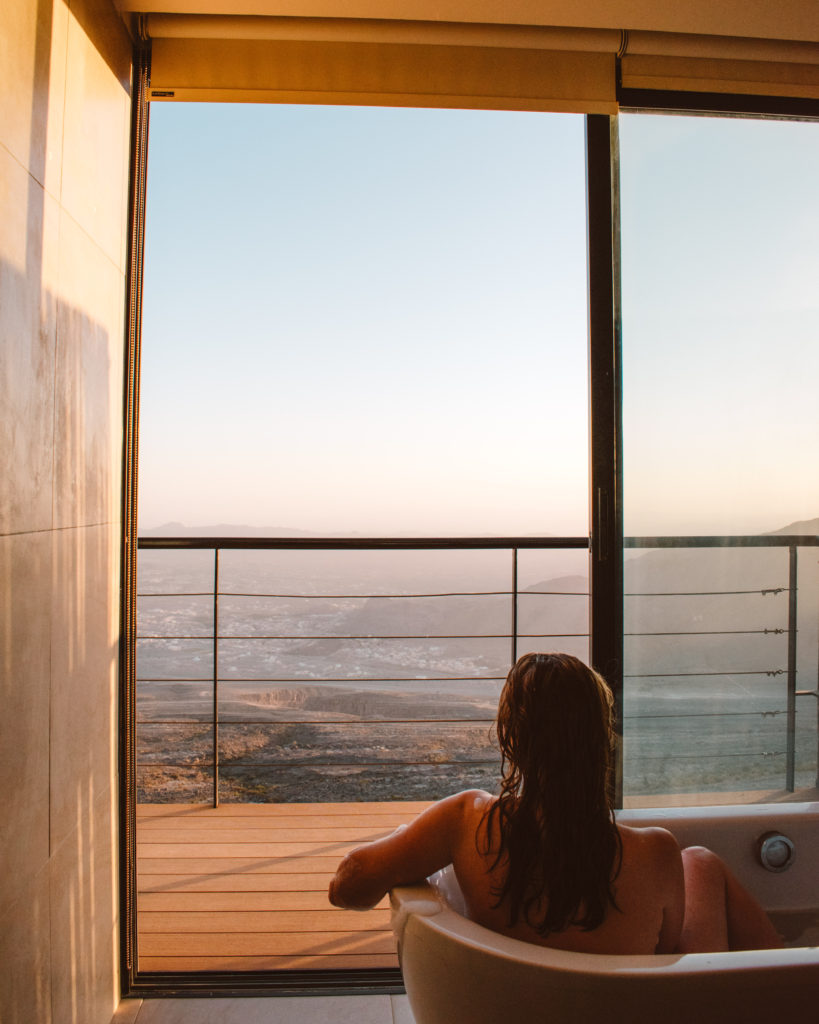
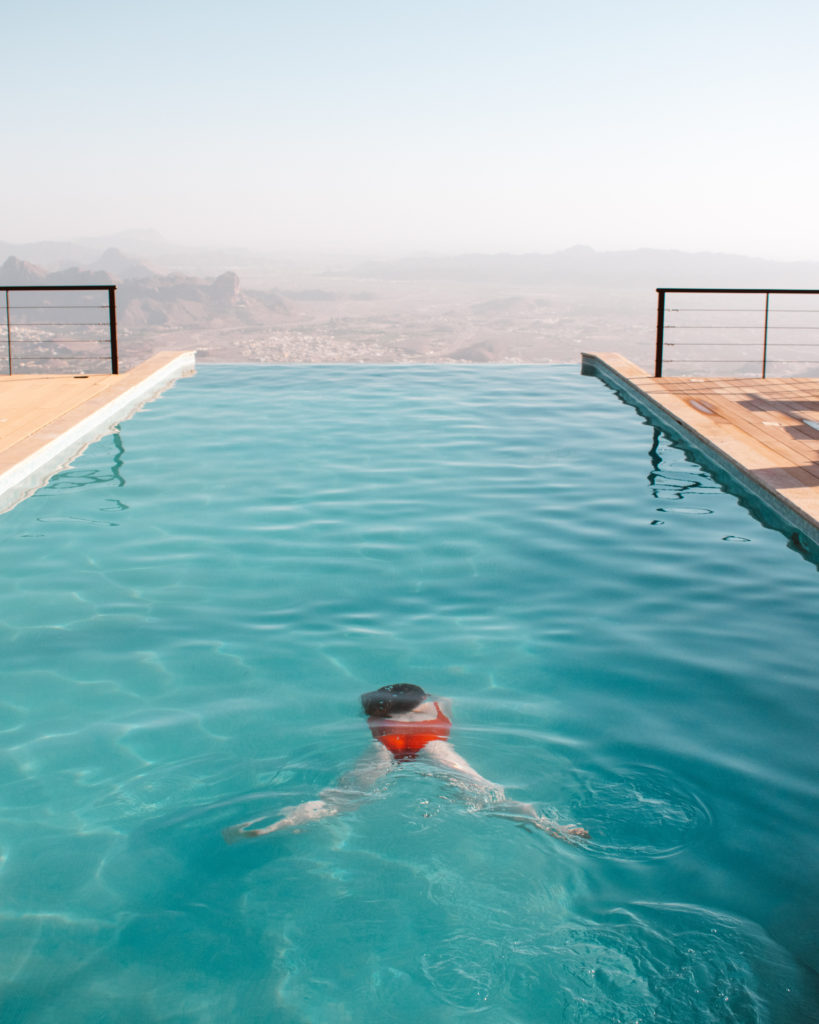
The View (££) – a really wonderful hotel! A fraction of the cost of the Alila or Anantara on Jebel Akhdar, but with amazing views and a real feeling of being perched on the edge of Jebel Shams. Accessible with a 2WD. Fantastic infinity pool, with views over Al Hamra. Rooms all have private terraces out over the view, and the night time views from the bathtub are gorgeous. Check out my full review for more details.
I really hope this has given you a glimpse of the variety of history, adventure and luxury that Oman can offer! I think the Western Hajar should find a space on all road trip itineraries – and ideally you would have the chance to make it to both Jebel Akhdar and Jebel Shams! Check out the rest of my Oman guides for help planning your itinerary, or other destinations for more inspiration.




Leave a Reply